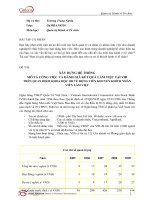Hành vi tổ chức OB mid
Bạn đang xem bản rút gọn của tài liệu. Xem và tải ngay bản đầy đủ của tài liệu tại đây (91.9 KB, 18 trang )
<span class="text_page_counter">Trang 1</span><div class="page_container" data-page="1">
Q. 1: Which of the following terms indicates the tendency of individuals to spend less effort when working collectively?
</div><span class="text_page_counter">Trang 2</span><div class="page_container" data-page="2">Q. 4: Which of the following is true about emotions?
A. They are critical to rational thinking.
B. They are less intense than moods.
C. They are experienced over several days or months.
<b>D. They are never caused by specific events.</b>
Q. 5: Which of the following represents the acceptable standards of behavior within a group that are shared by the group's members?
</div><span class="text_page_counter">Trang 3</span><div class="page_container" data-page="3"><b>A. Women tend to hold onto emotions longer than men.</b>
B. Men experience emotions more intensely than women.
C. Men are more emotionally expressive than women.
D. Women express anger more frequently than men.
Q. 9: According to Henry Mintzberg, a factory supervisor giving a group of high school students a tour ofthe plant may be termed as a
A. negotiator
C. resource allocator
<b>B. figurehead</b>
</div><span class="text_page_counter">Trang 4</span><div class="page_container" data-page="4">D. leader
Q. 10: Joann Hayes is currently working on a project to tackle climate change. During the project, she needs to find different options to replace the use of non-renewable energy and check the feasibility of different renewable energy options before choosing the most practical one. Which of the following skills does Hayes primarily need to use for these tasks?
<b>C. Groupshift</b>
D. Social loafing
Q. 12: refers to evaluative statements or judgments concerning objects, people, or events.
</div><span class="text_page_counter">Trang 5</span><div class="page_container" data-page="5">A. Demeanor
B. AppearanceC. Behavior
</div><span class="text_page_counter">Trang 6</span><div class="page_container" data-page="6">Q. 15: A person who is made fun of because he is an Arab-American is being subjected to…, a kind of discrimination in work environments.
</div><span class="text_page_counter">Trang 7</span><div class="page_container" data-page="7">A. a counteraction
C. a reaction
B. a response
<b>D. a mood</b>
Q. 20: A situation in which an employee expresses organizationally desired emotions during interpersonal
transactions at work is known as
<b>A. emotional labor</b>
</div><span class="text_page_counter">Trang 8</span><div class="page_container" data-page="8">Q. 23: According to the Rokeach Value Survey, values refer to desirable end- states.
<b>A. terminal</b>
B. CriticalC. instrumentalD. essential
</div><span class="text_page_counter">Trang 9</span><div class="page_container" data-page="9">Q. 24: …bias indicates the tendency of an individual to attribute his or her own successes to internal factors while putting the blame for failures on external factors.
<b>Myers-A. rely on unconscious processes and look at the overall picture</b>
B. prefer routine and order and focus on details
</div><span class="text_page_counter">Trang 10</span><div class="page_container" data-page="10">C. outgoing, sociable, and assertive in nature
D. use reason, rationality, and logic to handle problems and situations
Q. 27: Among the Big Five model traits, ….is most strongly related to lifesatisfaction, job satisfaction, and low stress levels.
D. emotional/impulsive
Q. 29: During the third stage of group development,
A. members resist the constraints the group places on them
<b>B. intragroup conflicts occur</b>
</div><span class="text_page_counter">Trang 11</span><div class="page_container" data-page="11">C. the group demonstrates cohesiveness
D. conflicts over leadership are common
Q.30: Which of the following personality traits indicates the degree to which a person is unemotional and pragmatic and believes that ends can justify means?
</div><span class="text_page_counter">Trang 12</span><div class="page_container" data-page="12">D. increasing growth opportunities
Q. 33: Which of the following does systematic study use to look at relationships to attribute causes and effects?
</div><span class="text_page_counter">Trang 14</span><div class="page_container" data-page="14"><b>B. psychological empowerment</b>
D. organizational dissent
Q. 39: Johanna Reid, a campaign manager at a child rights organization, recently started working on an illiteracy project. During a child right organizotivate team members to attain their project milestones and direct project he needed phases of the project. Which of the following kinds of functions will these tasks be covered under?
</div><span class="text_page_counter">Trang 15</span><div class="page_container" data-page="15">Q. 43: Which of the following is an example of the affective component of an attitude?
A. believing that one achieved all objectives of a project
B. relying on the information of a company's annual report
<b>C. perceiving whistle-blowing as the right thing to do</b>
D. feeling hurt at being unfairly accused of a wrongdoing
Q. 44: The degree to which a person identifies with his or her job, actively participates in it, and considershis or her performance as being important to self-worth is referred to as
A. emotional contagion
</div><span class="text_page_counter">Trang 16</span><div class="page_container" data-page="16">C. job stability
<b>B. job involvement</b>
D. emotional dissonance
Q. 45: Which of the following is the most likely reason why employers should employ older workers?
A. They adjust to new technology promptly.
B. Older workers are flexible and learn quickly.
C. They have shorter tenures and hence lower pension benefits than younger workers.
<b>D. Older workers have extensive work experience.</b>
Q. 46: ….refers to a positive feeling about one's job resulting from an evaluation of its characteristics.
</div><span class="text_page_counter">Trang 18</span><div class="page_container" data-page="18"><b>A. Emotions are reactions to a person or event.</b>
B. Emotions last for a longer time period than moods.
C. Emotions are never action-oriented in nature.
D. Emotions lack a contextual stimulus
</div>








